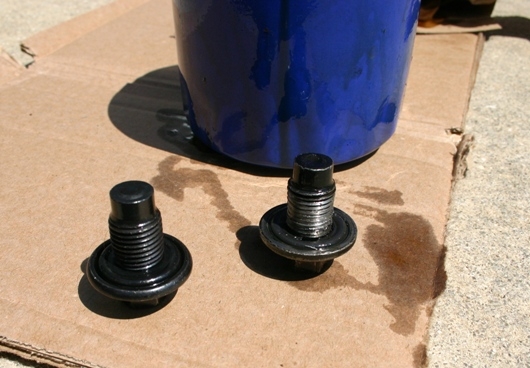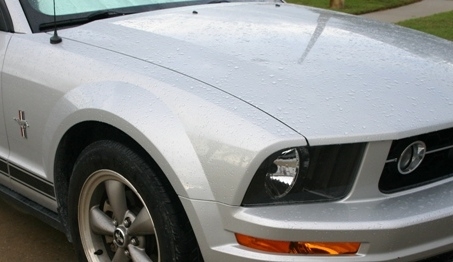Stripped Oil Pan Threads – What to Do
March 20, 2011 9:48 am TIME-SERT Kits© DenLorsTools.com Summary: A story of an experienced car technician helping his son do an oil change. Suggestions on how to handle stripped threads related to the oil drain plug and oil drain pan.
Recently, I was helping my son do an oil change on his newly acquired 2006 Mustang (26,000 miles). He changed the oil in his previous vehicle only a few times; since I’m the father and a Master Tech, it was my job to help walk him through it. It’s funny how sometimes when you are teaching someone how to do something on a car, things don’t go as planned. After working on cars for over twenty five years and doing countless oil changes, they have become so second nature that nothing could be easier, right? Well, I expected my son’s first oil change on his new Mustang to take about 15 minutes. It took a little longer because we ran into a snag.
 This picture was taken on the next oil change, notice how bad the threads were.
This picture was taken on the next oil change, notice how bad the threads were.
I wanted to just be there to guide him and help him avoid a beginner’s mistake like double gasketing the oil filter. I’ll explain, sometimes when removing an oil filter the rubber gasket can stick to the oil filter adapter housing. If this is not noticed and removed, when the new oil filter is installed there will be 2 gaskets. Next will be a massive oil leak when the car is started. If you’ve ever done this (most mechanics have) you’ll never want to repeat it.
I had him safely drive the Mustang up on the car ramps and place a pair of jack stands underneath the car as a precaution. I made the point to him never to trust a jack or car ramps ALONE. I almost lost a friend years ago when a jack leaked while he was underneath changing a starter (that’s a different story). Back to my son’s first Mustang oil change. When he went to remove the drain plug, it was coming out “tight” the whole way. My son doesn’t have much experience working on cars, but he does have a lot of natural mechanical ability. He sensed this was wrong and told me. OK, so much for letting him do all the “hands on.” I got underneath and felt the drain plug. Yep, tight all the way. Maybe, it was better that things didn’t go just as planned. If it did, he wouldn’t learn much. I explained to him that it’s always best if this happens, to turn the ratchet a little at a time. Working it slightly back and forth helps to clean the threads. Now, this is a metal oil pan on the Mustang and is NOT as susceptible to stripped threads as cars that have aluminum oil pans. So how did this happen he asked? There’s usually a couple of reasons that the threads become stretched like this I explained. 1. Over tightening. Some guys get a little carried away and over torque the drain plug. 2. Using an angled wrench and applying sideways force. That’s why it’s best to use a ratchet if possible (as long as clearance allows). When using a ratchet, you naturally have a 90 degree application of force, which helps prevent tweaking or stretching the threads.
I was able to work the drain plug and get it freed up. After I removed it, I could see the threads were OK in the pan but a little rough on the drain plug itself. I made the decision to re-use the drain plug this time. On the next oil change we will have picked up a replacement drain plug at the parts store and be prepared to replace the worn one.
If there is something stripped it’s best for it to be the drain plug. The drain plug can be replaced for a few bucks. If the drain pan is damaged it could be replaced for several hundred dollars. Another option for drain pan thread repair is to use the proper size, TIME-SERT Metal Drain Pan thread repair kit. Many auto repair shops have these on hand in case there’s a problem. The kit can pay for itself with just ONE use.
The next time my son’s car needs an oil change, HE’S doing it. I’ll be where I belong, watching him from my chair with an icy cold beverage.
Related Car Repair Articles and Products
TIME-SERT 0765 Ford Oil Drain Pan Thread Repair Kit

Bill :
Date: April 20, 2011 @ 1:56 pm
I find this a lot with DIY’rs. they call and explain the problem. Of course they caused it but they take it out on us anyway. It’s an easy fix for a pro with the right tools but layin on your back in the driveway it may seem a bit intimidating. Great Info here on this site BTW.